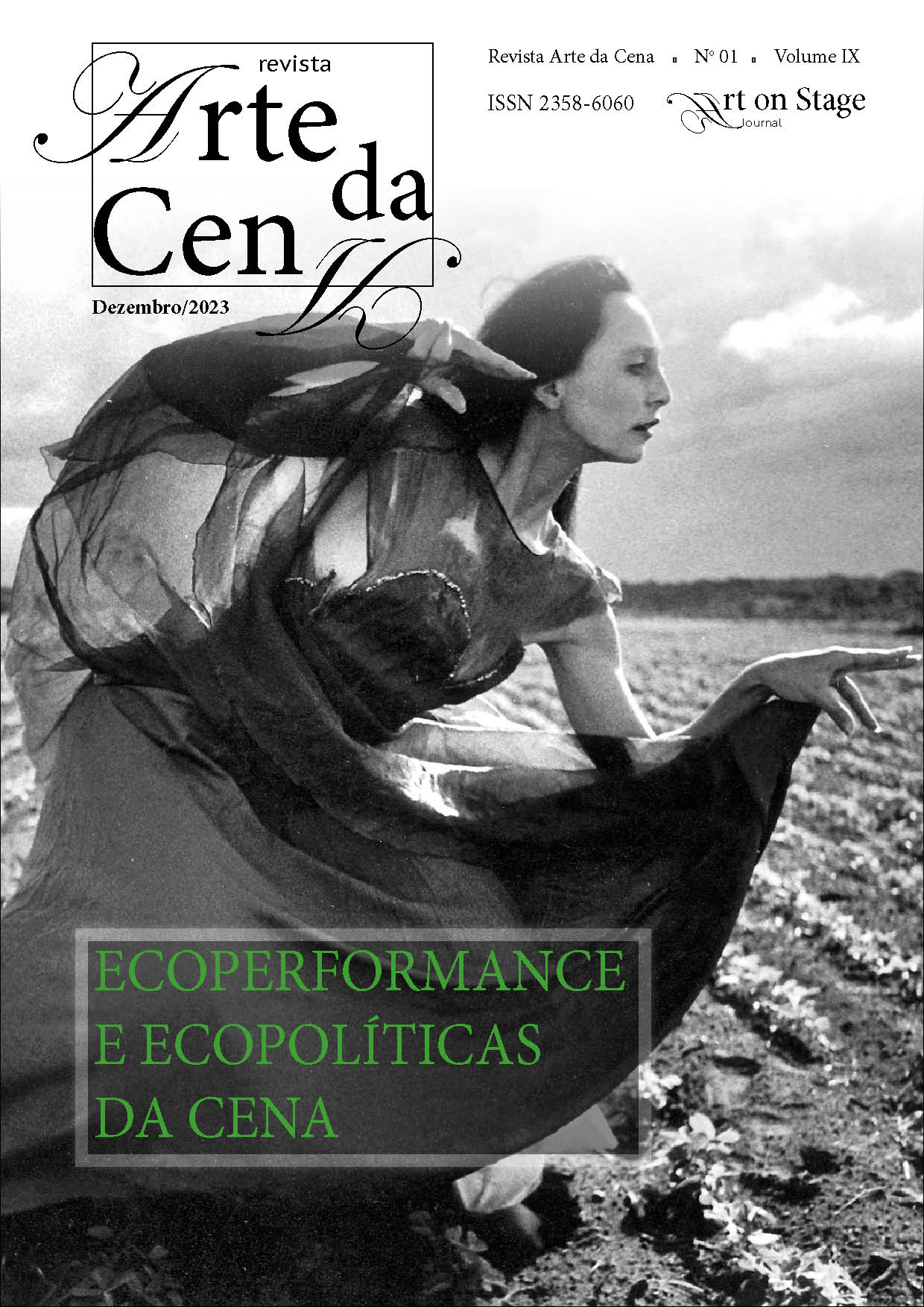FILES OF THE “ABSURDITY” AND METATHEATRE IN TENNESSEE WILLIAMS’ WORK
A Comparative Analysis of The Two-Character Play and Out Cry
DOI:
https://doi.org/10.5216/ac.v9i1.74123Abstract
This article critically analyzes the main differences and similarities between The Two-Character Play and Out Cry, by Tennessee Williams. They are plays with the same plot, but with significant differences in narrative form. The main objective is to identify the autobiographical relationships, verify the formal resources that associate them with the so-called theater of the absurd and the Pirandello´s meta-theatrical work, as well as other possible contributions from the experimental theater of the US countercultural years and off-off-Broadway. In addition, it presents the two plays, their reception, synopsis, context, and the conditions in which they were written. It also points out the Brazilian stage montages and their contexts. In conclusion, the reference to experimental devices of the metatheater and the so-called theater of the absurd allows opening doors of understanding and aesthetic paths not associated with the playwright in Brazil.
Downloads
References
ABEL, Leonel. Metateatro – Uma nova visão da forma dramatúrgica. Rio de Janeiro: Zanar, 1968. 190 p.
ANOUILH, Jean. Five Plays: Antigone, Eurydice, The Ermine, The Rehearsal, Romeo and Jeannette. Strass Farrar; Giroux Farrar (Trad.). New York: Hill and Wang, 1990. 340 p.
BECKETT, Samuel. Esperando Godot. Fábio de Souza Andrade (Trad.). São Paulo: Companhia das Letras, 2017. 192 p.
BECKETT, Samuel. Fim de partida. Fábio de Souza Andrade (Trad.). São Paulo: Cosac Naif, 2002b. 174 p.
BECKETT, Samuel. Happy Days. New York: Grove Atlantic Press, 1989. 64 p.
BERGMAN, Ingmar. Riten. Youtube, s/d. Disponível em: <https://www.youtube.com/watch?v=UU5Q59-hjV0>. Acesso: 30 mai. 2021.
CAMUS, Albert. O mito de Sísifo – Um ensaio sobre o absurdo. Ari Roitman; Paulina Watch (Trad.). Lisboa: Livros do Brasil, 2010. 163 p.
COSTA, Fernando da. O processo de criação Inveja dos anjos do Armazém Companhia de Teatro. Dissertação (Mestrado em Teatro). Centro de Letras e Artes, Universidade Federal do Estado do Rio de Janeiro, Rio de Janeiro, 2012. 111p. Disponível em: <https://www.repositório-bc.unirio.br>. Acesso: 25 mai. 2021.
DEVLIN, Albert J. Conversations with Tennessee Williams. Jackson: University Press of Mississippi, 1986. 369 p.
DORFF, Linda. Disfigured Stages: The Late Plays of Tennessee Williams, 1958-1983. Thesis (Doctor of Philosophy). New York: University of New York, 1997. 401 p.
ELORZA, Thelma. O exercício de metalinguagem. In: Folha de Londrina, 17 fev. 1997. Disponível em: <https://www.folhadelondrina.com.br/folha-2/o-exercicio-de-metalinguagem-9977.html>. Acesso em: 25 mai. 2021.
FALK, S. L. Tennessee Williams. Maria T. P. Moraes (Trad.). Rio de Janeiros: Lidador, 1966. 187 p.
FUNARTE. Berro, novo espetáculo do Grupo Tapa, chega ao Arena (SP). In: FUNARTE – Portal das Artes, 02 ago. 2013. Disponível em: <http://www.funarte.gov.br/teatro/>. Acesso em: 25 mai. 2021.
GENET, Jean. O balcão. Jacqueline Castro; Martim Gonçalves (Trad.). Rio de Janeiro: Civilização Brasileira, 1970. 160 p.
GENET, Jean. The Blacks: A Clown Show. Bernard Fletchman (Trad.) New York: Grove Atlantic Press, 1994. 98 p.
LONDRÉ, Felicia Hardison. Tennessee Williams. New York: Frederick Ungar Publishing, 1981. 213 p.
LONDRÉ, Felicia Hardison. The Two-Character Out Cry and Break Out. In: KOLIN, Philip C. (Ed.). The Undiscovered Country: The Later Plays of Tennessee Williams. New York: Peter Lang Publishing, 2002. p. 93-106.
PIRANDELLO, Luigi. Ciascuno a suo modo. Edizioni Scrivere, 2018. 98p. (e-Book).
PIRANDELLO, Luigi. Esta noite se improvisa. Sérgio N. Melo (Trad.). São Paulo: Tordesilhas, 2020. 169 p.
PIRANDELLO, Luigi. O falecido Mattia Pascal/Seis personagens à procura de um autor. Fernando Correa Fonseca (Trad.). São Paulo: Nova Cultural, 2002. 366 p.
PROSSER, William. The Late Plays of Tennessee Williams. Lanham: Scarecrow, 2009. 285 p.
WEISS, Peter. Marat/Sade. São Paulo: Abril Cultural, 1977. 134 p.
WILLIAMS, Tennessee. Dragon Country. New York: New Directions, 1970. 278 p.
WILLIAMS, Tennessee. Grito D´alma (Out Cry). Francisco Carneiro da Cunha (Trad.). Pará de Minas: Virtual Books, 2003. 53 p. (e-book).
WILLIAMS, Tennessee. Memoirs. New York: New Directions, 2006. 500 p.
WILLIAMS, Tennessee. No bar de um hotel de Tóquio e outras peças. José Camões; Manuel João Gomes (Trad.). Lisboa: Artistas Unidos/Cotovia, 2015. 228 p.
WILLIAMS, Tennessee. Out Cry. New York: New Directions, 1973. 86 p.
WILLIAMS, Tennessee The Two-Character Play. In: Plays 1957-1980. New York: The Library of America, 2000. p. 771-824.
WILLIAMS, Tennessee. The Two-Character Play. New York: New Directions, 1997. 63 p.
ZOLOTOW, Sam. ‘The Rose Tatoo’ to Continue Run; City Center Will Move It Into the Billy Rose. New York Times, October 26, 1966. Disponível em: <https://www.nytimes.com/1966/10/26/archives/the-rose-tattoo-to-continue-run-city-center-will-move-it-into-the.html>. Acesso: 25 mai. 2021.
Downloads
Published
How to Cite
Issue
Section
License
Copyright (c) 2023 Luis Marcio Arnaut de Toledo

This work is licensed under a Creative Commons Attribution-NonCommercial 4.0 International License.
The Art on Stage Journal uses the Creative Commons - Attribution-Non-Commercial 4.0 International license as a basis for transferring rights, for open access journals (Open Archives Initiative - OAI).
Authors who publish in this journal agree with the following terms:
1) Authors retain the copyright and grant the Art on Stage Journal the right to first publication, with the work simultaneously licensed under the Creative Commons Attribution Non Commercial License.
2) Authors are authorized to assume additional contracts separately, for non-exclusive distribution of the version of the work published in this Journal (eg, publishing in institutional repository or as a book chapter), with acknowledgment of authorship and initial publication in this journal.
3) Authors are allowed and encouraged to publish and distribute their work online (eg in institutional repositories or on their personal page) at any point before or during the editorial process, provided that the reference to the place of publication is cited, that is, the electronic address / reference of Art on Stage Journal.
4) The authors of the works published in the Art on Stage are expressly responsible for their content.
5) Authors will not be paid for publication of works in the Art on Stage Journal.



